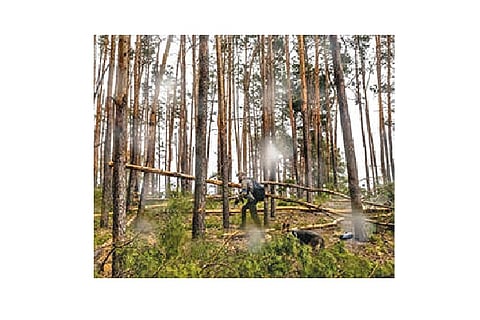

“Today the territory of the reserve is occupied by the Russian troops,” Oleksandr Krasnolutskyi, a deputy minister of environmental protection and natural resources in Ukraine, said in an email last month. “Currently there is no information on environmental losses.” But military activity in the area sparked fires large enough to be seen from space, prompting concerns about the destruction of critical bird breeding habitats. “We see what’s happening in Ukraine,” said Thor Hanson, an independent conservation biologist and expert on how wars affect the environment. “And we are horrified for the human cost first and foremost, but also what’s happening to the environment there.”
Since Russian forces invaded Ukraine in February, the world’s attention has been focused on the nation’s heavily shelled cities. But Ukraine, in an ecological transition zone, is also home to vibrant wetlands and forests and a large swath of virgin steppe. Russian troops have already entered, or conducted military operations in, more than one-third of the nation’s protected natural areas, Krasnolutskyi said: “Their ecosystems and species have become vulnerable.”
Reports from the ground, and research on previous armed conflicts, suggest that the ecological impact of the conflict could be profound. Wars destroy habitats, kill wildlife, generate pollution and remake ecosystems entirely, with consequences that ripple through the decades.
“The environment is the silent victim of conflicts,” said Doug Weir, the research and policy director at the Conflict and Environment Observatory, a non-profit organisation based in Britain. There are exceptions. Wars can make landscapes so dangerous or inhospitable to humans — or create so many barriers to the exploitation of natural resources — that ecosystems have a rare opportunity to recover. It is a paradox that highlights the threat that human activity poses to the natural world in times of war and peace. “Humans are generally disruptive,” said Robert Pringle, a biologist at Princeton University, “and that includes their conflicts.”
Waging war is an act of destruction. And, studies suggest, it’s one that disproportionately affects the planet’s most important ecosystems. From 1950 to 2000, more than 80 percent of the world’s major armed conflicts took place in biodiversity hot spots, areas that are rich in native species but under threat, Dr. Hanson and his colleagues found in a 2009 study. The take-home message, Dr. Hanson said, “was that if we were concerned about biodiversity and conservation in the world, we need to be worried also about conflict and patterns of conflict.”
There has been little large-scale research on the ecological impact of warfare, but in one 2018 study, scientists found that armed conflict was correlated with declines in wildlife across protected areas of Africa. Wildlife populations tended to be stable in peacetime and decline during war, the researchers found, and the more frequent the conflicts, the steeper the declines.
Anthes is a journalist with NYT©2022
The New York Times
Visit news.dtnext.in to explore our interactive epaper!
Download the DT Next app for more exciting features!
Click here for iOS
Click here for Android